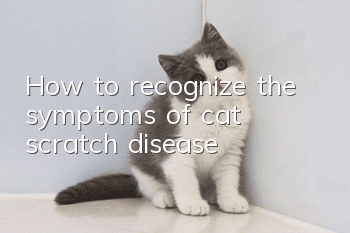How to recognize the symptoms of cat scratch disease?

The first sign that a cat scratch wound may be infected is redness, swelling and inflammation around the wound; open sores or pus-filled pimples also indicate an infection that will appear less than two weeks after contamination; look for swollen lymph nodes : Lymph nodes close to the site of infection can become swollen and painful, most commonly in the head, neck, and upper limbs.
Check for redness and swelling
The first sign that a wound may be infected is redness, swelling and inflammation around the wound. This may occur within 3 to 14 days of exposure to the cat. If you think you have cat-scratch fever, see your doctor.
Observe any papules or pustules
You may notice the growth of small blisters or lesions around the wound. These open sores or pus-filled pimples also indicate an infection that will appear less than two weeks after contamination. No epidemic or outbreak of pustules. This can lead to the spread of infection.
Look for swollen lymph nodes
One to three weeks after exposure to Bartonella henselae, your lymph nodes near the site of infection may become swollen and painful. These are most common on the head, neck, and upper limbs. Look for small, round bumps near the bite or scrape.
Pay attention to fatigue
If you experience cat-scratch disease, you may become more tired than usual. You usually feel tired, even after a restful sleep, and become more tired while doing tasks. If you feel tired, be sure to avoid overexertion and be sure to get plenty of rest.
Treating headaches
Cat-scratch disease can give you a headache that can appear within a few days of exposure. Use recommended doses of pain relievers to manage headaches.
Control low-grade fever
A mild fever may also occur due to infection. Fever is a relatively common symptom of cat-scratch disease, but it is not serious. Use fever-reducing medicine. If the fever worsens, see your doctor.
Observe for severe muscle or joint pain
Rarely, people infected with cat-scratch disease develop joint and muscle pain. Those who report muscle and joint pain tend to be under 20 years old. If left untreated, it can lead to chronic tendonitis and persistent muscle and joint pain. Contact your doctor if you experience joint or muscle pain associated with cat-scratch disease.
Check for eye redness and blurred vision
In rare cases, cat-scratch disease has caused vision loss and limited field of vision. If you experience poor vision or changes in vision, contact your doctor. It can be cleared up with a dose of antibiotics.
Looking for lesions
In people with compromised immune systems, this can cause bacterial angiomatosis through lesions on the skin. This can manifest as ulcers in the skin, subcutaneous tissue, bones, or other organs. For people with compromised immune systems, the lesions are particularly dangerous because they increase the likelihood of infection. This complication is most common in people infected with HIV.
Pay attention to neurological symptoms
You can develop encephalopathy (brain damage or dysfunction), radiculopathy (localized nerve damage), or ataxia (loss of muscle coordination) from cat-scratch disease. Patients with encephalopathy often experience confusion and disorientation. You may also have epilepsy or other neurological problems. Most symptoms usually resolve with treatment, but some people are left with residual neurological deficits from cat-scratch fever.
Check for blood in your urine
Bacterial purpura may be caused by an infection of the blood vessels in the liver or spleen. If you have bacterial purpura, you will have small amounts of blood in your urine, which may cause a dark discoloration. If left untreated, this infection can cause serious deterioration in the health of people with compromised immune systems. This complication occurs almost exclusively in people infected with HIV.
- How should a pregnant cat eat? A guide to caring for pregnant female cats!
- What's going on with the cat's stomach twitching?
- How many years does the silver gradient generally last?
- What should I do if my kitten is under one month old and has fleas?
- Kitten Feeding Guide The Most Complete Kitten Feeding Guide
- Grasp these three points to help you identify British shorthair cats at a glance
- What should I do when my kitten first arrives in a new home?
- What vaccinations should kittens receive?
- Will stray cats recognize their owners if they eat cat food?
- Can cats eat cheese rice cake? Cats can eat cheese rice cake but you can't



